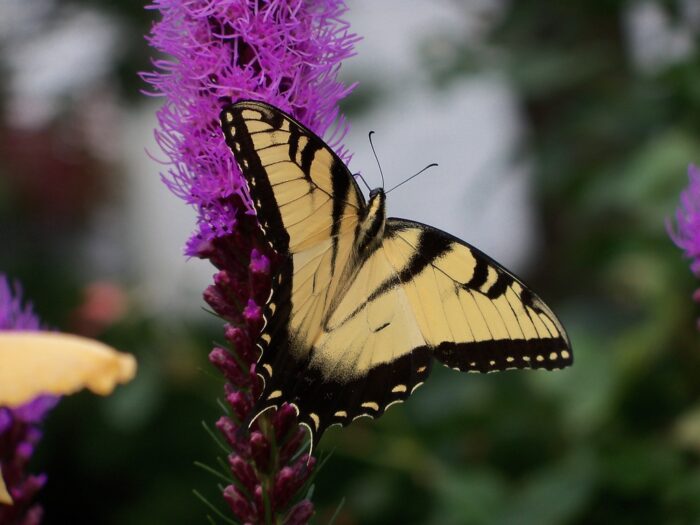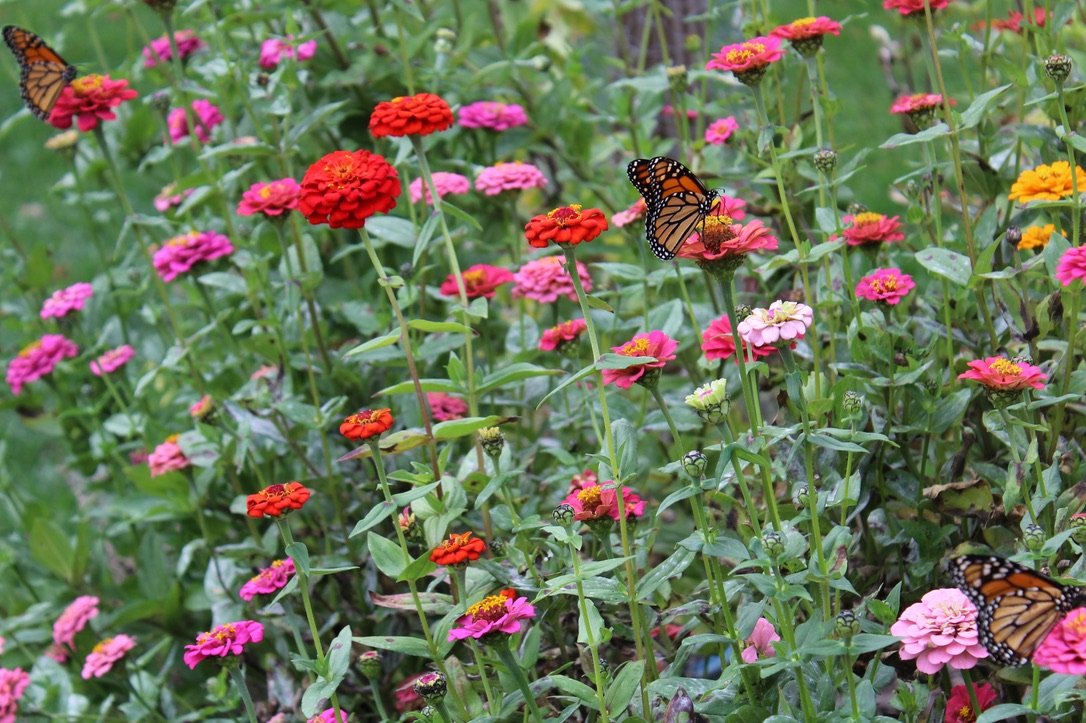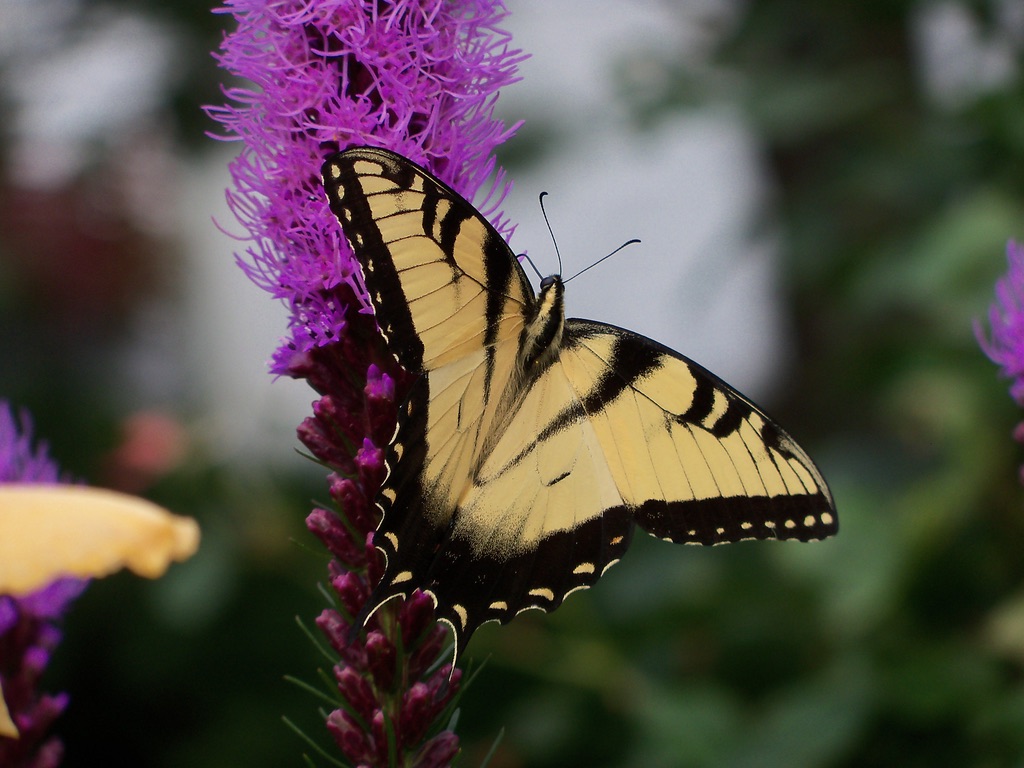
Today’s photos are from Barb Mrgich in East Berlin, Pennsylvania (Zone 6b). We’ve visited Barb’s beautiful garden before (From Barren Lot to Pollinator Paradise), and today’s she’s focusing on all the beautiful butterflies that visit her garden.
One of the best things about gardening for wildlife is learning more about butterflies and enjoying their beauty. The two species of butterfly I see most often in my gardens are monarchs and eastern tiger swallowtails. The swallowtail is a resident (spends its winter right here in PA), and the monarch is a migrating butterfly who flies well over a thousand miles to spend its winter in Mexico.
 A monarch gathers nectar from tithonia (Tithonia rotundifolia, annual), a flower that is popular with many pollinators.
A monarch gathers nectar from tithonia (Tithonia rotundifolia, annual), a flower that is popular with many pollinators.
 A lovely eastern tiger swallowtail gathers nectar from a zinnia.
A lovely eastern tiger swallowtail gathers nectar from a zinnia.
 To attract more butterflies, it’s important to understand a few general details. All butterflies start out as a tiny egg on a suitable host plant. The egg hatches into a threadlike caterpillar that eats the leaves of the host plant. When large enough, the caterpillar forms a chrysalis, where it will undergo complete metamorphosis and emerge as a butterfly. Monarchs lay their eggs on milkweed. These milkweed leaves have been brought into the house to protect them from predators.
To attract more butterflies, it’s important to understand a few general details. All butterflies start out as a tiny egg on a suitable host plant. The egg hatches into a threadlike caterpillar that eats the leaves of the host plant. When large enough, the caterpillar forms a chrysalis, where it will undergo complete metamorphosis and emerge as a butterfly. Monarchs lay their eggs on milkweed. These milkweed leaves have been brought into the house to protect them from predators.
 These are full-grown monarch caterpillars. They will soon be ready to form their chrysalises.
These are full-grown monarch caterpillars. They will soon be ready to form their chrysalises.
 A monarch has now formed its chrysalis, where will remain until it emerges as a butterfly. The chrysalis of most butterflies is not nearly as attractive as that of the monarch. Notice the gold line that encircles the top like a jeweled necklace! This is attached to the top of the jar where I brought the eggs for safe-keeping. When the monarch is ready to fly, I will release it into the garden.
A monarch has now formed its chrysalis, where will remain until it emerges as a butterfly. The chrysalis of most butterflies is not nearly as attractive as that of the monarch. Notice the gold line that encircles the top like a jeweled necklace! This is attached to the top of the jar where I brought the eggs for safe-keeping. When the monarch is ready to fly, I will release it into the garden.
 The adult butterfly has no mouth parts to eat leaves like the caterpillars. It can only sip nectar through its proboscis, a strawlike part that rolls up when not in use. Most adult butterflies live only a couple weeks. In order to convince butterflies to stay on your property, you need both host plants and nectar plants. Zinnia is a favorite nectar plant for many butterflies. Plant a patch of zinnias, and they will come!
The adult butterfly has no mouth parts to eat leaves like the caterpillars. It can only sip nectar through its proboscis, a strawlike part that rolls up when not in use. Most adult butterflies live only a couple weeks. In order to convince butterflies to stay on your property, you need both host plants and nectar plants. Zinnia is a favorite nectar plant for many butterflies. Plant a patch of zinnias, and they will come!
 In my area of Pennsylvania, I generally see monarchs in late summer after July 1. Sometimes around Halloween, flocks of migrating monarchs arrive in a large group. They really like my zinnia and tithonia patch. On this late October day, I counted around 15 but could only get these three at one time in a picture.
In my area of Pennsylvania, I generally see monarchs in late summer after July 1. Sometimes around Halloween, flocks of migrating monarchs arrive in a large group. They really like my zinnia and tithonia patch. On this late October day, I counted around 15 but could only get these three at one time in a picture.
 The eastern tiger swallowtail is also predominantly yellow in color but quite different in appearance from a monarch, though also very easy to recognize. It winters over as a chrysalis right here in my garden. Its chrysalis is designed to blend in and look like part of its host tree. It is very hard to spot. I have never seen a chrysalis in the wild. Here is an eastern tiger swallowtail nectaring on a liatris (Liatris spicata, Zones 3–8), another native perennial that’s very popular with the pollinators. Notice its two tails. When you see that, you can recognize a swallowtail. There are many other swallowtails besides the tiger. Other swallowtails that have visited my gardens are the black, spicebush, and giant.
The eastern tiger swallowtail is also predominantly yellow in color but quite different in appearance from a monarch, though also very easy to recognize. It winters over as a chrysalis right here in my garden. Its chrysalis is designed to blend in and look like part of its host tree. It is very hard to spot. I have never seen a chrysalis in the wild. Here is an eastern tiger swallowtail nectaring on a liatris (Liatris spicata, Zones 3–8), another native perennial that’s very popular with the pollinators. Notice its two tails. When you see that, you can recognize a swallowtail. There are many other swallowtails besides the tiger. Other swallowtails that have visited my gardens are the black, spicebush, and giant.
 Invite black swallowtails into your garden by including plants from the carrot family. These are all easy plants to grow in nearly any garden. Parsley, fennel, and, of course, carrots are familiar to almost everyone. Other neat plants of the same family that work are golden alexanders (Zizia aurea, Zones 3–8), rue (Ruta graveolens, Zones 4–8), and even Queen Anne’s lace (Daucus carota, Zones 3–8). These are the plants where black swallowtails will lay their eggs. The butterfly will then sip on all the good nectar plants, including zinnias, phlox, liatris, coneflowers (Echinacea, Zones 4–8), and tithonia. Here is a black swallowtail enjoying the nectar of a zinnia.
Invite black swallowtails into your garden by including plants from the carrot family. These are all easy plants to grow in nearly any garden. Parsley, fennel, and, of course, carrots are familiar to almost everyone. Other neat plants of the same family that work are golden alexanders (Zizia aurea, Zones 3–8), rue (Ruta graveolens, Zones 4–8), and even Queen Anne’s lace (Daucus carota, Zones 3–8). These are the plants where black swallowtails will lay their eggs. The butterfly will then sip on all the good nectar plants, including zinnias, phlox, liatris, coneflowers (Echinacea, Zones 4–8), and tithonia. Here is a black swallowtail enjoying the nectar of a zinnia.
 My littlest granddaughters and I saw this black swallowtail caterpillar munching away on parsley in a children’s garden at a local garden center. There is hardly any parsley left, but it’s worth the sacrifice to see the beautiful butterfly it will become. Most caterpillars are fuzzy, but this one and the monarch are not. They are the two most beautiful caterpillars I have ever seen.
My littlest granddaughters and I saw this black swallowtail caterpillar munching away on parsley in a children’s garden at a local garden center. There is hardly any parsley left, but it’s worth the sacrifice to see the beautiful butterfly it will become. Most caterpillars are fuzzy, but this one and the monarch are not. They are the two most beautiful caterpillars I have ever seen.
Barb shared so many wonderful butterflies, and information about attracting them to your garden, that we’ll be back tomorrow to see more.
Have a garden you’d like to share?
Have photos to share? We’d love to see your garden, a particular collection of plants you love, or a wonderful garden you had the chance to visit!
To submit, send 5-10 photos to [email protected] along with some information about the plants in the pictures and where you took the photos. We’d love to hear where you are located, how long you’ve been gardening, successes you are proud of, failures you learned from, hopes for the future, favorite plants, or funny stories from your garden.
Have a mobile phone? Tag your photos on Facebook, Instagram or Twitter with #FineGardening!
Do you receive the GPOD by email yet? Sign up here.

















Comments
Beautiful and informative! Thanks for sharing your photos and knowledge with us. Such information can help us in preparing next year's gardens. Do you set out butterfly puddlers?
Yes. Puddlers are helpful for butterflies because they are too small and fragile to drink from ponds and birdbaths. They actually prefer mud puddles. A large plant saucer filled with sand and a couple rocks does the trick. It is difficult to keep up because it dries out way too quickly. Then sometimes, a hard rain washes out the sand.
Wonderful photos! I had the most butterflies, many different varieties, in my garden this year that I've ever seen. I have lots of native plants and don't use pesticides (but lots of people in the neighbor do!) so it seems that they've found a sanctuary here. Thank you for sharing!
Barb, thanks for answering my query about puddlers. I use a clay saucer as a base for one and you are right, they are difficult to keep filled but worth the effort. Thanks.
Oh wow! This has been such an educational post! I'm in 6b also in Pittsburgh, and I learned a lot from you! Thanks for great photos and text. I will save this post to my Pinterest Garden Folder!!! and I would also like to add that one summer I tossed out apple slices for wild life and butterflies were attracted to them...I can't recall what kind it was now.
Log in or create an account to post a comment.
Sign up Log in